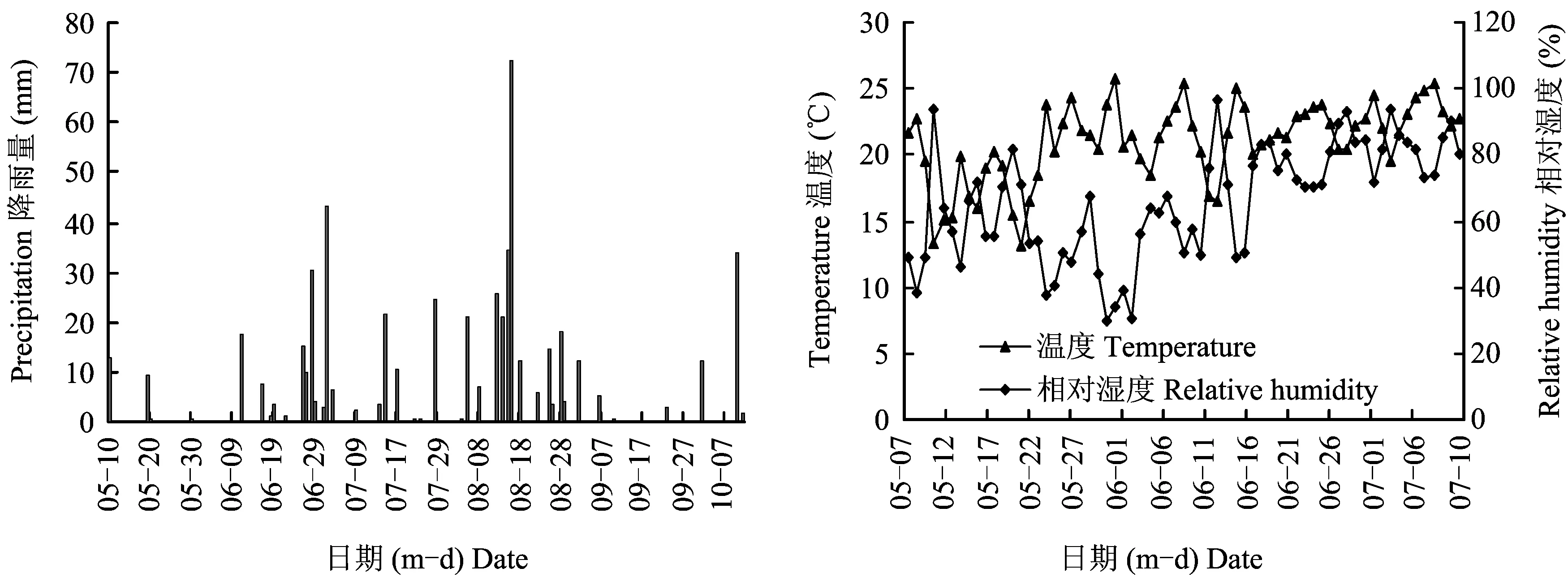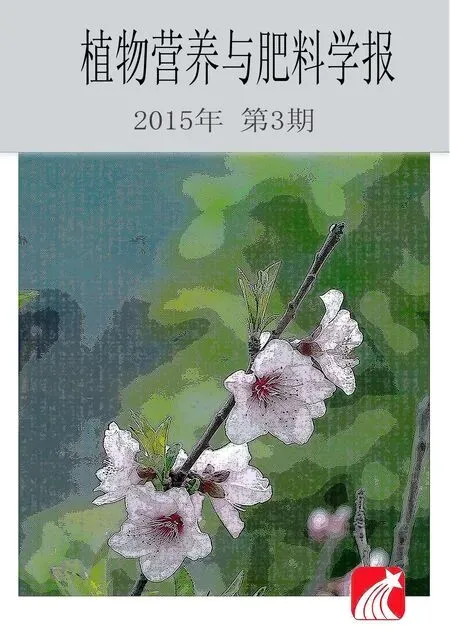不同类型高氮复混(合)肥氨挥发特性及其对氮素平衡的影响
李雨繁, 贾 可, 王金艳, 冯国忠, 焉 莉, 邓 超, 李 辉, 高 强*
(1吉林农业大学资源与环境学院,吉林长春 130118; 2 中国-阿拉伯化肥有限公司农化中心,秦皇岛 066000;3吉林省梨树县榆台镇农业技术推广站,吉林梨树 136506)
不同类型高氮复混(合)肥氨挥发特性及其对氮素平衡的影响
李雨繁1, 贾 可2, 王金艳3, 冯国忠1, 焉 莉1, 邓 超1, 李 辉1, 高 强1*
(1吉林农业大学资源与环境学院,吉林长春 130118; 2 中国-阿拉伯化肥有限公司农化中心,秦皇岛 066000;3吉林省梨树县榆台镇农业技术推广站,吉林梨树 136506)

玉米; 一次性施肥; 新型肥料; 氨挥发; 氮素平衡

一次性施肥方式采用的肥料类型主要为含氮量较高的复混(合)肥,如高塔肥料、掺混肥料等。随着新型肥料生产的快速发展,控释肥料、脲甲醛肥料和稳定性肥料在一次性施肥中的比例不断增加。目前在玉米上应用新型肥料的研究主要集中在单一新型肥料增产效果和氮素残留方面[5-7],只有少数研究者针对控释肥料、脲甲醛肥料、稳定性肥料中的其中一种进行了氨挥发状况的研究[8-9],就相同养分条件下,对不同类型新型肥料在玉米上的增产效果及氨挥发特性尚不明确,而这方面的研究,对指导东北地区玉米合理施用氮肥具有重要的科学意义。
1 材料与方法
1.1 试验区概况


图1 2013年试验区降雨量及氮肥施用后氨挥发测定期间的温度和湿度Fig.1 Air temperature, relative humidity and precipitation after the basal application of the nitrogen fertilizers in 2013
1.2 试验设计
试验共7个处理:1)对照(N0),不施氮肥; 2)常规施肥(Con), 用氮磷钾比例15-15-15的复合肥+尿素; 3)高塔肥料(HT); 4)掺混肥(BB),尿素+二铵+氯化钾; 5)控释肥(CRF),硫包衣复合肥; 6)脲甲醛肥(UF),脲甲醛树脂包衣复合肥; 7)稳定性肥料(SF), 同时添加脲酶抑制剂和硝化抑制剂的复合肥。 除对照外,各处理氮磷钾比例为28-11-11。各处理施肥量相同,均为N 224 kg/hm2、P2O588 kg/hm2、K2O 88 kg/hm2,每个处理3次重复。小区面积40 m2,6垄一个小区,各小区间隔2 m,作为保护行,以避免各小区间相互污染。各小区排列原则为:施氮量较高的处理位于下风向,施氮量较低的处理位于上风向。施肥方式为: 常规施肥处理的氮肥分为基肥和追肥,基追肥比例为1 ∶2,分别以条施和沟施的方式施入,追肥日期为6月24日(拔节期),施肥深度为5—8 cm;其他施氮处理均采用一次性条施的方式,施肥深度为10—12 cm。
1.3 测定项目和方法


图2 氮肥施入后土壤的氨挥发速率 Fig.2 Ammonia volatilization rates from soil after the basal application of nitrogen fertilizers
土壤氨挥发速率的计算公式为:

1.3.3 产量的测定及植株样品的采集 在玉米成熟期,将试验小区两侧边行各1垄及小区两端各0.8 m去掉,其余部分作为收获区,面积为22.8 m2。记录测产面积内实际株数、穗数、果穗总鲜重,按平均单穗重取有代表性的10穗(10穗的平均单穗重应与收获区的平均单穗重相同),称取鲜重带回实验室,考种后烘干测干重,计算含水量,折算测产区产量,最后得出每公顷产量(14%)。
在每个小区选择3株有代表性的玉米植株,装入网袋带回实验室,分为秸秆和籽粒,烘干后全部粉碎,采用常规方法测定植株中的氮含量[12]。
1.4 数据处理
氮肥利用率及氮平衡的计算方法[13-14]:
氮肥利用率(%)=(施氮区吸氮量-无氮区吸氮量)/施氮量×100
土壤氮素净矿化量(kg/km2)=不施氮肥区地上部分氮积累量+不施氮肥区土壤残留无机氮量-不施氮肥起始无机氮量
氮表观损失量(kg/km2)=氮输入量-氮输出量
氮肥表观损失率(%)=氮表观损失/施氮量×100
氮肥土壤残留率(%)=100-氮肥利用率-表观损失率
试验数据采用SAS进行统计分析。
2 结果与分析
2.1 氮肥施入后土壤的氨挥发


图3 氮肥施入后土壤的氨挥发累积量 Fig.3 Cumulative ammonia volatilization amount from soil after the basal application of nitrogen fertilizers
2.2 不同类型高氮复混(合)肥对玉米产量及氮素利用的影响


表1 不同氮肥处理的产量及氮肥利用率
注(Note): 同列数据后不同字母表示处理间差异达5%显著水平 Values followed by different letters in a column are significant among treatments at the 5% level.
差异。CRF、UF、SF 3个处理的氮肥当季利用率分别为27.9%、37.7%和28.8%;植株吸氮量分别为277.5、299.3和279.3 kg/hm2,均高于其他处理,主要原因在于CRF、UF和SF 3个处理的玉米植株含氮量明显较高(表1),原因可能是,在本试验条件下以上3种新型肥料可明显促进玉米植株对氮素的吸收。
2.3 收获后各处理不同土层无机氮的分布


图4 玉米收获后铵态氮、硝态氮和无机氮在0—100 cm土层的分布 Fig.4 The distribution of -N, -N and Nmin in the 0-100 cm soil profile after the harvest of maize
2.4 不同肥料对土壤-作物体系中氮素平衡的影响

3 讨论
3.1 不同氮肥的氨挥发
影响氨挥发的主要因素包括土壤条件、环境因子及施肥状况[15]。在本试验条件下,肥料类型和施肥方式是影响氨挥发的2个显著因素。常规施肥处理的基肥施用量仅为74 kg/hm2,仅占玉米生育期氮肥总施用量的1/3,但其氨挥发速率和氨挥发累积量均明显高于其他处理,且峰值出现时间较早,但拔节期追施尿素后土壤的氨挥发速率并没有明显升高。这与王东、纪玉刚等[16-17]提出的氨挥发速率和氨挥发累积量随施氮量增加而增加,且玉米追肥后的氨挥发速率和氨挥发累积量均高于基肥期的结论不符。这是由于常规施肥处理的施肥深度与一次性施肥方式相比明显较浅,肥料施入土壤后迅速溶解并在脲酶的作用下水解,使土体中的氨浓度升高,很容易在短时间内造成氨挥发损失。但在玉米追肥后出现连续降雨,且降雨量达41.73 mm,将施入土壤中的氮素直接淋洗到土壤深层中,表层土壤中的尿素减少,使氨挥发损失降低。控释肥和脲甲醛肥施入土壤后,包膜材料和缓溶性物质阻隔肥料与土壤脲酶的直接接触及减少氨挥发底物尿素态氮的溶出,从而达到降低和延缓土壤氨挥发的效果[18-19]。稳定性肥料中的脲酶抑制剂可有效降低脲酶活性,这是其氨挥发较低的重要原因。

表2 施氮量为224 kg/hm2条件下玉米全生育期的氮素平衡
注(Note): 同列数据后不同字母表示处理间差异达5%显著水平 Values followed by different letters in a column are significant among treatments at the 5% level.
3.2 玉米收获后土壤无机氮累积与分布

3.3 不同氮肥施用后土壤-作物体系的氮素平衡

在本试验中,氮肥表观损失率在氮肥输出项中占主要地位,各施氮处理的氮肥表观损失率均大于高强[26]等在黑钙土上的研究结果,其主要原因在于该试验地块土壤自身供氮量已达275 kg/hm2(土壤氮素矿化量与播前无机氮数量的总和),基本满足玉米全生育期的氮素需求。由此可以看出,在供试土壤肥力较高的条件下,春玉米一次性施肥方式的氮肥施用量可适当降低,降低幅度有待进一步研究。
4 结论

[1] 中华人民共和国农业部.中国农业年鉴[M]. 北京: 中国农业出版社, 2012. Ministry of Agriculture of China. China agriculture yearbook[M]. Beijing: China Agriculture Press, 2012.
[2] 安景文, 汪仁, 包红静, 等. 不同肥料配方一次性施肥对玉米产量和养分吸收的影响[J]. 土壤通报. 2008, 39(4): 874-877. An J W, Wang R, Bao H Jetal. Effects of basal dressing total fertilizers once with different fertilizer formulas on product and nutrient uptake of maize[J].China Journal Soil Science. 2008, 39(4): 874-877.
[3] 高强, 李德忠, 汪娟娟, 等. 春玉米一次性施肥效果研究[J]. 玉米科学, 2007, 15(4): 125-128. Gao Q, Li D Z, Wang J Jetal. Effects of Single fertilization for spring maize[J]. Journal of Maize Sciences. 2007, 15(4): 125-128.
[4] 高强, 冯国忠, 王志刚. 东北地区春玉米施肥现状调查[J]. 中国农学通报, 2010, 26(14): 229-231. Gao Q, Feng G Z, Wang Z G. Present situation of fertilizer application on spring maize in northeast China[J]. China Agricultural Science Bullet, 2010, 26(14): 229-231.
[5] 朱红英, 董树亭, 胡昌浩. 不同控释肥料对玉米产量及产量性状影响的研究[J]. 玉米科学, 2003,11(4): 86-89. Zhu H Y, Dong S T, Hu C H. Research on yield and characters of maize in different controlled release fertilizer[J]. Journal of Maize Sciences. 2003, 11(4): 86-89.
[6] Diez J A, Roman R, Cartagena M Cetal. Controlling nitrate pollution of aquifers by using different nitrogenous controlled release fertilizers in maize crop[J]. Agericulture Ecosystems & Environment, 1994, 48(1): 49-56.
[7] 王小明, 谢迎新, 张亚楠, 等. 新型肥料施用对玉米季土壤硝态氮累积的影响[J]. 水土保持学报, 2009, 23(5): 232-236. Wang X M, Xie Y X, Zhang Y N. Effect of new type fertilizers application on accumulation of soil nitrate nitrogen in the maize season[J]. Journal of soil and water conservation, 2009, 23(5): 232-236.
[8] 卢艳艳, 宋付朋. 不同包膜控释尿素对农田土壤氨挥发的影响[J]. 生态学报, 2011, 31(23): 7133-7140. Lu Y Y, Song F P. Effects of different coated controlled-release urea on soil ammonia volatilization in farmland[J]. Acta Ecologica Sinica, 2011, 31(23): 7133-7140.
[9] 张文学, 孙刚, 何萍, 等. 脲酶抑制剂与硝化抑制剂对稻田氨挥发的影响[J]. 植物营养与肥料学报, 2013, 19(6): 1411-1419. Zhang X W, Sun G, He Petal. Effects of urease and nitrification inhibitors on ammonia volatilization from paddy fields[J]. Plant Nutrition and Fertilizer Science, 2013, 19(6): 1411-1419.
[10] 王朝辉, 刘学军, 巨晓棠, 等. 田间土壤氨挥发的原位测定—通气法[J]. 植物营养与肥料学报, .2002, 8(2): 205-209. Wang Z H, Liu X J, Ju X Tetal. Field in situ determination of ammonia volatilization from soil: Venting method[J]. Plant Nutrition and Fertilizer Science, 2002, 8(2): 205-209.
[11] 杨宪龙, 路永莉, 同延安, 等. 长期施氮和秸秆还田对小麦-玉米轮作体系土壤氮素平衡的影响[J]. 植物营养与肥料学报, 2013, 19(1): 65-73. Yang X L, Lu Y L, Tong Y Aetal. Effects of long-term N application and straw returning on N budget under wheat-maize rotation system[J]. Plant Nutrition and Fertilizer Science, 2013, 19(1): 65-73.
[12] 鲍士旦. 土壤农化分析(第三版) [M]. 北京: 中国农业出版社, 2000. 34-109. Bao S D. Soil agricultural chemistry analysis [M]. Beijing: China Agriculture Press, 2000. 34-109.
[13] 巨晓棠, 刘学军, 张福锁. 冬小麦与夏玉米轮作体系中氮肥效应及氮素平衡研究[J]. 中国农业科学, 2002, 35(11): 1361-1368. Ju X T, Liu X J, Zhang F S. Study on effect of nitrogen fertilizer and nitrogen balance in winter wheat and summer maize rotation system[J]. Scientia Agricultural Sinica, 2002, 35(11): 1361-1368.
[14] 刘学军, 赵紫娟, 巨晓棠, 等. 基施氮肥对冬小麦产量、氮肥利用率及氮平衡的影响[J]. 生态学报, 2002, 22(7): 1122-1128. Liu X J, Zhao Z J, Ju X Tetal. Effect of N application as basal fertilizer on grain yield of winter wheat, fertilizer N recovery and N balance[J]. Acta Ecologica Sinica, 2002, 22(7): 1122-1128.
[15] Olesen J E, Rubk G H, Heidmann Tetal. Effect of climate change on greenhouse gas emissions from arable crop rotations[J]. Nutrient Cycling in Agroecosystems, 2004, 70(2): 147-160.
[16] 王东, 于振文, 于文明, 等. 施氮水平对高产麦田土壤硝态氮时空变化及氨挥发的影响[J]. 应用生态学报, 2006,17(9): 1593-1598. Wang D, Yu Z W, Yu W Metal. Effects of nitrogen application level on soil nitrate accumulation and ammonia volatilization in high-yielding wheat field[J]. Chinese Journal of Applied Ecology, 2006,17(9): 1593-1598.
[17] 纪玉刚, 孙静文, 周卫, 等. 东北黑土玉米单作体系氨挥发特征研究[J]. 植物营养与肥料学报, 2009, 15(5): 1044-1050. Ji Y G, Sun J W, Zhou Wetal. In situ study of ammonia volatilization from black soil with maize monoculture system[J]. Plant Nutrition and Fertilizer Science, 2009, 15(5): 1044-1050.
[18] 陈易飞, 朱永绥, 朱风根, 等. 脲甲醛肥在稻麦生产上的应用效果初报[J]. 江苏农业科学, 2000,(5): 49-51. Chen Y F, Zhu Y S, Zhu F Getal. Effects of urea-formaldehyde fertilizer 0n rice and wheat[J]. Jiangsu Agricultural Sciences, 2000,(5): 49-51.
[19] 谷佳林, 边秀举, 徐凯, 等. 不同缓控释肥对高羊茅草坪生长及氮素挥发的影响[J]. 草业学报2013, 2(22): 235-242. Gu J L, Bian X J, Xu Ketal. Effects of different slow/controlled release nitrogen fertilizer on tall fescue turf growth and nitrogen volatilization[J]. Acta Prataculturae Sinica, 2013, 2(22): 235-242.
[20] 蔡红光, 米国华, 张秀芝, 等. 不同施肥方式对东北黑土春玉米连作体系土壤氮素平衡的影响[J]. 植物营养与肥料学报, 2012,18(1): 89-97. Cai H G, Mi G H, Zhang X Zetal. Effect of different fertilizing methods on nitrogen balance in the black soil for continuous maize production in Northeast China[J]. Plant Nutrition and Fertilizer Science, 2012, 18(1): 89-97.
[21] 王朝晖, 李生秀, 王西娜, 等. 旱地土壤硝态氮残留淋溶及影响因素研究[J]. 土壤, 2006, 38(6): 676-681. Wang Z H, Li S X, Wang X Netal. Nitrate nitrogen residue and leaching in dryland soil and influence factors[J]. Soils, 2006, 38(6): 676-681.
[22] Hofma G, Nutrient management legislation in European countries [R]. NUMALEC Report. Concerted Action, Fair 6-C 98-4215, 1999.
[23] 钟茜, 巨晓棠, 张福锁. 华北平原冬小麦/夏玉米轮作体系对氮素环境承受力分析[J]. 植物营养与肥料学报, 2006, 12(3): 285-293. Zhong Q, Ju X T, Zhang F S. Analysis of environmental endurance of winter wheat/summer maize rotation system to nitrogen in North China Plain[J]. Plant Nutrition and Fertilizer Science, 2006,12(3): 285-293.
[24] 张福锁, 王激清, 张卫峰, 等. 中国主要粮食作物肥料利用率现状与提高途径[J]. 土壤学报, 2008, 45(5): 915-924. Zhang F S, Wang J Q, Zhang W Fetal. Nutrient use efficiencies of major cereal crops in China and measures for improvement[J]. Acta Pedologica Sinica, 2013, 46(15): 3161-3171.
[25] 杨俊刚, 高强, 曹兵, 等. 一次性施肥对春玉米产量和环境效应的影响[J].中国农学通报, 2009, 25(19): 123-128. Yang J G, Gao Q, Chao Betal. Effect of single fertilization on spring maize yield and environment[J]. Chinese Agricultural Science Bulletin, 2009, 25(19): 123-128.
[26] 高强, 蔡红光, 黄立华, 等. 吉林省半干旱地区春玉米连作体系氮素平衡研究[J]. 西北农林科技大学学报(自然科学版), 2009, 37(8): 127-132. Gao Q, Cai H G, Huang L Hetal. Study on soil nitrogen balance of spring maize continuous cropping in semiarid area of Jilin province[J]. Journal of Northwest A&F University(Natural Science Edition),2009, 37(8): 127-132.
Ammonia volatilization characteristics of different kinds of high-nitrogen compound fertilizers and their effects on nitrogen balance
LI Yu-fan1, JIA Ke2, WANG Jin-yan3, FENG Guo-zhong1, YAN Li1, DENG Chao1, LI Hui1, GAO Qiang1*
(1CollegeofResourcesandEnvironmentalSciences,JilinAgriculturalUniversity,Changchun130118,China;2AgrochemicalCenterofChina-ArabianFertilizerCo.Ltd,Qinhuangdao,Hebei066000,China;3AgriculturalTechnologyExtensionStationofYutaiTown,Jilin,Lishu136500,China)
【Objectives】 With development of single fertilization as a main fertilization practice of maize(ZeamaysL.) in northeast China, proportion of high nitrogen compound fertilizers such as controlled release fertilizer, urea formaldehyde fertilizer, and stability fertilizer in the single fertilization increases. In order to clear effects of the yield increase and ammonia volatilization status of different types of high nitrogen compound fertilizers on maize(ZeamaysL.) in the same nutrient condition, a field experiment was conducted in a chernozem with maize(ZeamaysL.) cropping in the center of Jilin Province, China. 【Methods】 The experiment was conducted from May to October 2013 in chernozem soil in the Huangjiawobao village in Lishu County of Jilin Province with 7 treatments, which were the treatment without nitrogen application(N0), conventional fertilizer(Con), the high-tower fertilizer compound fertilizer processed in high tower(HT), bulk blanding fertilizer(BB), controlled-release fertilizer(CRF), urea formaldehyde fertilizer(UF) and stability fertilizer(ST). Each treatment was replicated 3 times. The conventional fertilizer was basal and top-dressed in proportion of 1 ∶2, the other fertilizaters were all basal applicated completely with rate of N, P2O5and K2O in 224, 88, and 88 kg/hm2. The ammonia volatilization was tested by a ventilation methodinsituafter the fertilization. Soil samples in the 0-100 cm soil layer were collected by drilling before sowing and after harvest. The yield of each treatment was weighted, three plants were selected in each plot and divided into straw and grain, the nitrogen uptake was calculated. 【Results】 The nitrogen fertilizer application increases the yields significantly. Compared with N0, the yield increase ranges from 18.9% to 24.1%, there are not significant differences among the different types of fertilizers, and the yield are from 12197 to 12899 kg/hm2. The utilization rates of the controlled release fertilizer(CRF), urea formaldehyde fertilizer(UF), and stability fertilizer(ST) are 27.9%, 37.7% and 28.8%, respectively, and the plant nitrogen uptake amounts are 277.5, 299.3 and 279.3 kg/hm2, respectively, which are higher than those in the other treatments. The ammonia volatilization rates at different periods after the fertilizer application show that the overall rate of ammonia volatilization is firstly increased and then decreased, the differences of ammonia volatilization rates of the treatments mainly concentrate in the 3-13 days after the fertilization, the peak of the ammonia volatilization rate is in oreder: conventional fertilization(Con) > high-tower fertilizer(HT) > mixing fertilizer(BB) > controlled release fertilizer(CRF) > stability fertilizer(ST) > urea formaldehyde fertilizer(UF). The ammonia volatilization amounts of the controlled release fertilizer, urea formaldehyde and stability fertilizer are 10.6, 8.1 and 10.3 kg/km2, respectively, which are equivalent to the amounts of the nitrogen fertilizer in 4.7%, 3.6% and 4.6% and significantly lower than the mixing fertilizer(14.8 kg/hm2) and the high-tower Fertilizer(23.0 kg/hm2). From the nitrogen balance in soil-crop system, it can be seen that the apparent loss amounts of the controlled release fertilizer, urea formaldehyde fertilizer and the stability fertilizer are 103, 79 and 73 kg/hm2, and significantly lower than those of the mixing fertilizer(136 kg/hm2) and high-tower fertilizer(123 kg/hm2). The mixing fertilizer, controlled release fertilizer, urea formaldehyde fertilizer and stability fertilizer improve the nitrogen utilization rate of 7.7%-17.5%, and reduce the nitrogen loss effectively. 【Conclusions】 In chernozem soil and single fertilization mode, the yields of different types of high nitrogen compound fertilizer have no significant differences, which are ranged from 12197 to 12899 kg/hm2. Compared with the mixing fertilizer(BB), the controlled release fertilizer(CRF), urea formaldehyde fertilizer(UF) and stability fertilizer(ST) promote the plant nitrogen uptake, and the utilization rates are improved by 38.1%-86.6%, the ammonia volatilization rates are reduced by 40%-96.5% and the amounts of ammonia volatilization loss are reduced by 39.2%-81.3%. The controlled release fertilizer, urea formaldehyde fertilizer and stability fertilizer effectively keep soil inorganic nitrogen content in corn growth period within an acceptable range and guarantee soil nitrogen supply.
maize; single fertilizer application in one crop season; new type fertilizer; ammonia volatilization; nitrogen balance
2014-01-22 接受日期: 2014-07-07 网络出版日期: 2015-02-13
公益性行业(农业)专项-农作物最佳养分管理技术研究与应用(201103003);国家玉米产业技术体系(CARS)项目资助。
李雨繁(1987—),女,吉林长春人,硕士研究生,主要从事植物营养与肥料方面的研究。E-mail: yufan0511@126.com * 通信作者 E-mail: gyt199962@163.com
S513.062; S153.6+1
A
1008-505X(2015)03-0615-09

